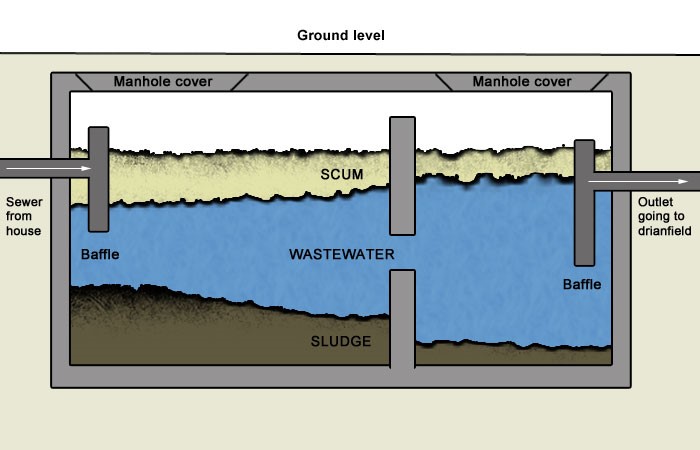
More than half a million domestic properties within the UK aren’t connected to mains drainage, operating off septic tanks instead. The majority of these homes are located in more rural parts of the UK, and so, if you’ve decided to join the 126% of UK people contemplating a move to villages in search of more of a country-esque style living, you may have to get to know what a septic tank is and how it works.
Septic tanks are located underground within both domestic dwellings and commercial properties, although this post will focus on homes rather than business premises.
‘Septic’ translates to ‘infected with microorganisms,’ and septic systems refer to the method homeowners use to dispose of the household plumbing produced when there’s no connection to the mains sewer.
You may also have heard of cesspits that store organic matter in a similar way. The main difference is that a septic tank holds (good) bacteria that break down waste, whereas cesspits simply store it until it is emptied.
The precise process for breaking down household plumbing from kitchens, laundry and bathroom plumbing is as follows:
Some septic tanks work with multiple chambers. When one is full it overflows into the next. Each chamber will separate the organic matter into the three layers of scum, sludge and effluent without any specific treatment being carried out.

A traditional septic system works by utilising two chambers, where the liquid waste flows into the next chamber when there is too much liquid in the first.
There aren’t any chemicals within a septic tank to treat wastewater, instead, natural processes separate the waste into three layers as mentioned in the section above. It’s vital that only the middle layer, the septic tank effluent, is allowed to flow out into the septic field.
At the inlet and outlets of the tank, T-pipes, also referred to as dips, ensure that nothing other than the effluent seeps through into the soakaway (such as grease, oils, food scraps or solid waste which would clog up the system and potentially pollute the surrounding soil).
This older style of system is still available today, bringing with it advantages and disadvantages:
Over the years advancements have been made to septic tanks. For example, modern septic tank systems are often made from GRP (Glass Reinforced Plastic), PE (polyethylene) or fibreglass rather than concrete.
While operating in the same manner as a brick septic tank system, instead of the T-shaped outlet used within brick tanks that prevent waste from entering the drainage field, a baffle is used – which is essentially a filtration device, ensuring no debris, scum or sludge gets into the soakaway.
Some designs consist of only one chamber and have removable easy-to-clean particle filters to help prevent heavier or lighter solids from entering the soakaway.
Here’s a breakdown of the pros and cons of opting for a more modern system:
The main aim of a septic tank is to remove solids before the water is allowed to discharge. Liquid wastewater contains ammonia and pathogens, making it unsuitable for discharging (seeping) into a ditch or stream as it would be toxic to fish and plant life. Therefore, water from septic systems must be discharged via a suitably sized drainage field.
The drainage field is an exceptionally important part of the process, ensuring that the wastewater percolates through the soil and is treated in a natural way that’s good for the environment before it gets to any underground water supply.
If, however, septic tanks aren’t maintained properly, harmful contaminations can seep into the groundwater. More than that, unmaintained drainage fields may result in the septic tank breaking down entirely, which for domestic properties that rely solely on these tanks for their waste disposal, would be a considerable headache.
Here are some test results on wastewater prior to a septic tank, from the septic tank to the drain field and then after the drainage field:
| Parameter | Raw waste | Septic tank Effluent | One foot below drainage field | Three Foot below drainage filed |
| BOD5 (mg/L) | 270-400 | 140-220 | 0 | 0 |
| TSS (mg/L) | 300-400 | 45-65 | 0 | 0 |
| Ammonia (mg/l) | 60-120 | 50-60 | 0 | 0 |
| Phosphorus (mg/L) | 10-40 | 10-30 | Trace | Trace |
| Viruses(PFU/ml) | Unknown | 1,000-1,000,000,000 | 0-1000 | 0 |
| Faecal Coliform (MPU)/100ml | 1,000,000-100,000,000 | 1000-1,000,000,000 | 0-100 | 0 |
As you can see, in this case, the septic tank offered very little reduction in BOD5 or ammonia (some of the measures we use to determine water quality), but a large reduction of TSS (total suspended solids).
Most of the treatment actually occurred in the drainage field. From this, you can see the importance of the drainage field in a septic system.
To reduce the chances of a septic tank breakdown, proper drainage field maintenance should be carried out, including:
The settled solids also need to be removed from the tank approximately once a year, typically you will use a septic tank emptying service. Not doing this increases the chances of the soakaway becoming blocked and creating unsavoury odours.
It is sometimes said that upgrading to a sewage treatment plant is a better option for people living in rural areas than relying on a septic tank, as a way of increasing the lifespan of the soakaway while also being kinder to the environment.
Whilst there is merit in this, there are ways to avoid a blocked drainage field, including the regular maintenance we mentioned above and ensuring good soakaway construction.
If, when installing a soakaway, you are able to incorporate ventilation at the end of the drainage field, you will allow airflow through the pipes which will help with the growth of Aerobic (good) bacteria.
If you’re considering buying a septic tank or getting your existing tank serviced, we have a number of services to make the process easier:
[Sewage Treatment Plant Servicing] [Sewage Treatment Plant Repairs] [Emptying and Desludging] [Home Buyers Survey]
If you’re ready to upgrade or are interested in having one installed, you’ll find a wide variety of septic tanks available at Owls Hall. When you buy through us, you can expect free delivery within five-to-ten days.